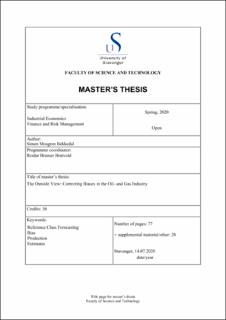| dc.contributor.advisor | Bratvold, Reidar Brumer | |
| dc.contributor.author | Bekkedal, Simen Mosgren | |
| dc.coverage.spatial | Norwegian continental shelf | en_US |
| dc.date.accessioned | 2020-10-12T08:36:08Z | |
| dc.date.available | 2020-10-12T08:36:08Z | |
| dc.date.issued | 2020-07-14 | |
| dc.identifier.uri | https://hdl.handle.net/11250/2682137 | |
| dc.description | Master's thesis in Industrial economics | en_US |
| dc.description.abstract | When companies want to operate and produce petroleum on the Norwegian continental shelf (NCS) they are generally required to make an extensive plan prior to the construction work. This is known as the plan for development and operation (PDO). The PDO addresses a number of decision relevant topics, including the estimated production rate on a year-by-year basis for the entire expected lifetime of the field. These estimates are reported as P10-, mean-, and P90 values. As will be demonstrated in this work, these estimates tend to be severely biased. The extent of this bias and procedures to reduce it will be illustrated and discussed.
The source material for this thesis is a data set containing estimates for 51 fields on the NCS. Analyzing the estimates, we find that the P10-P90 range, i.e., the 80 percent confidence intervals that the companies are requested to report in the PDO, only capture 40 percent of the true production outcomes. Furthermore, about 41 percent of these outcomes falls below the P10 values, on average. This suggests that assessors are generally overly precise and optimistic in their forecasts.
In an attempt to alleviate the bias, a modified reference class forecasting model has been applied to the data set. This methodology is a new adaptation of the classical reference class forecasting model, introduced by Kahneman and Tversky in the 1970s. The modified model calibrates the assessed P10-, mean- and P90 estimates, whilst the classical model uses solely the mean estimate and creates a new distribution from this single value. Since the modified model utilizes more information from the original forecast it was hypothesized that it would outperform the classical model. However, even though both models significantly reduced the bias in the estimates, the acquired results showed that the modified model is performing worse than the classical model. | en_US |
| dc.language.iso | eng | en_US |
| dc.publisher | University of Stavanger, Norway | en_US |
| dc.relation.ispartofseries | Masteroppgave/UIS-TN-ISØP/2020; | |
| dc.rights | Navngivelse 4.0 Internasjonal | * |
| dc.rights.uri | http://creativecommons.org/licenses/by/4.0/deed.no | * |
| dc.subject | industriell økonomi | en_US |
| dc.subject | reference class forecasting | en_US |
| dc.subject | bias | en_US |
| dc.subject | production | en_US |
| dc.subject | estimates | en_US |
| dc.title | The Outside View: Correcting Biases in the Oil- and Gas Industry | en_US |
| dc.type | Master thesis | en_US |
| dc.subject.nsi | VDP::Samfunnsvitenskap: 200::Økonomi: 210 | en_US |

